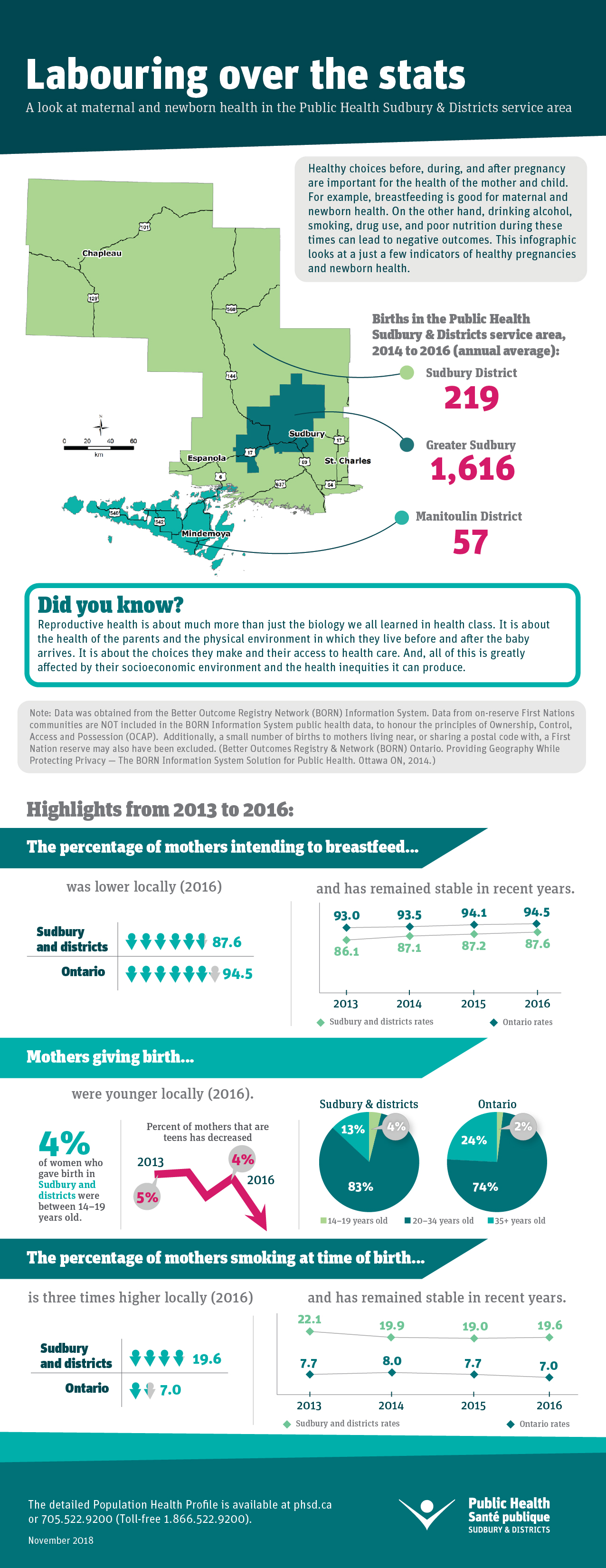Maternal and newborn health
The health of mothers and children can be affected by genetic endowment, the physical environment in which mother and child live, the effects of social and economic determinants, and lifestyle choices. Also, the health of the newborn is largely a function of the mother’s health and nutrition status and of her access to health care.
Reproductive health is affected by our health in childhood, important during adolescence and adulthood, sets the stage for health beyond the reproductive years for both women and men, and affects the health of the next generation.
The United Nations defines reproductive health as a state of complete physical, mental and social well-being, and not merely the absence of reproductive disease or infirmity. It deals with the reproductive processes, functions and system at all stages of life.
The information presented here pertains to births to mothers who reside in the Public Health Sudbury & Districts’ catchment area. Data was obtained from the Better Outcome Registry Network (BORN) Information System. Data from on-reserve First Nations communities are NOT included in the BORN Information System public health data, to honour the principles of Ownership, Control, Access and Possession (OCAP). Additionally, a small number of births to mothers living near, or sharing a postal code with, a First Nation reserve may also have been excluded. (Better Outcomes Registry & Network (BORN) Ontario. Providing Geography While Protecting Privacy- The BORN Information System Solution for Public Health. Ottawa ON, 2014.)
- Live births
- Multiple births
- Preterm births
- Stillbirths
- Congenital anomalies
- Low birth weight
- Very low birth weight
- Extremely low birth weight
- Small for gestational age
- Large for gestational age
- Intent to breastfeed
- Maternal age – 14 to 19 Years
- Maternal age – 35 Years and Older
- Maternal weight gain
- Smoking at time of birth
- Alcohol exposure during pregnancy
- Drug exposure during pregnancy
Maternal and Newborn Health Infographic
Healthy choices before, during, and after pregnancy are important for the health of the mother and child. For example, breastfeeding is good for maternal and newborn health. On the other hand, drinking alcohol, smoking, drug use, and poor nutrition during these times can lead to negative outcomes. This infographic looks at a just a few indicators of healthy pregnancies and newborn health.
Aussi disponible en français : Info graphique : santé des mères et des nouveau-nés

Births in the Public Health Sudbury & Districts service area, 2014 to 2016 (annual average):
- 219 births in Sudbury & District
- 1,616 births in Greater Sudbury
- 57 births in Manitoulin District
Did you know?
Reproductive health is about much more than just the biology we all learned in health class. It is about the health of the parents and the physical environment in which they live before and after the baby arrives. It is about the choices they make and their access to health care. And, all of this is greatly affected by their socioeconomic environment and the health inequities it can produce.
Highlights from 2013 to 2016:
- In 2016, the percentage of mothers intending to breastfeed was lower locally and has remained stable in recent years.
- 87.6% of mothers in Sudbury and districts were intending to breastfeed versus 94.5% of mothers in Ontario.
- In 2016, mothers giving birth were younger locally.
- 4% of women who gave birth in Sudbury and districts were between 14-19 years old.
- The percent of women between 14-19 years old who gave birth reduced from 5% in 2013 to 4% in 2016.
- 13% of mothers giving birth in Sudbury and districts were 35 years old or older compared to 74% in Ontario.
- 83% of mothers giving birth in Sudbury and districts were between the ages of 20 and 34 compared to 74% in Ontario.
- In 2016, the percentage of mothers smoking at time of birth is three times higher locally and has remained stable in recent years.
- 19.6% of mothers in Sudbury and districts were smoking at time of birth versus 7.0% of mothers in Ontario.
Note:
Data was obtained from the Better Outcome Registry Network (BORN) Information System. Data from on-reserve First Nations communities are NOT included in the BORN Information System public health data to honour the principles of Ownership, Control, Access and Possession (OCAP). Additionally, a small number of births to mothers living near, or sharing a postal code with, a First Nation reserve may also have been excluded. (Better Outcomes Registry & Network (BORN) Ontario. Providing Geography While Protecting Privacy — The BORN Information System Solution for Public Health. Ottawa ON, 2014.)
This item was last modified on February 26, 2021
